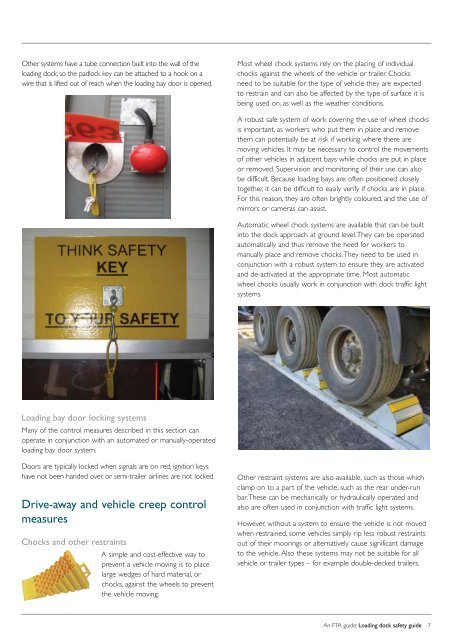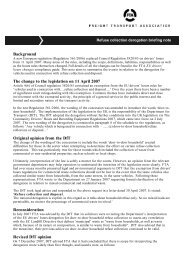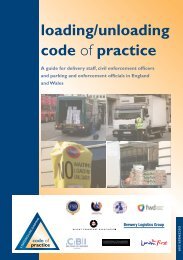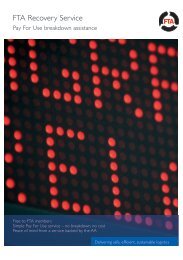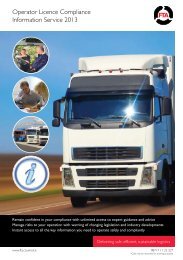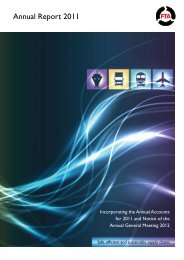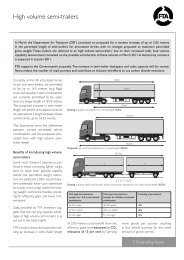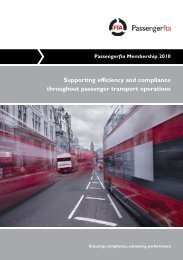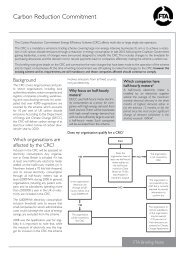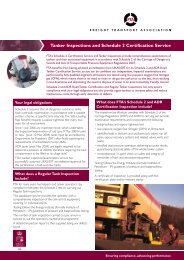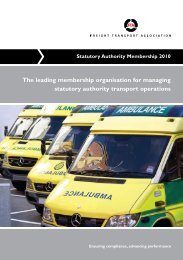Loading dock safety guide - Freight Transport Association
Loading dock safety guide - Freight Transport Association
Loading dock safety guide - Freight Transport Association
You also want an ePaper? Increase the reach of your titles
YUMPU automatically turns print PDFs into web optimized ePapers that Google loves.
Other systems have a tube connection built into the wall of theloading <strong>dock</strong>, so the padlock key can be attached to a hook on awire that is lifted out of reach when the loading bay door is opened.Most wheel chock systems rely on the placing of individualchocks against the wheels of the vehicle or trailer. Chocksneed to be suitable for the type of vehicle they are expectedto restrain and can also be affected by the type of surface it isbeing used on, as well as the weather conditions.A robust safe system of work covering the use of wheel chocksis important, as workers who put them in place and removethem can potentially be at risk if working where there aremoving vehicles. It may be necessary to control the movementsof other vehicles in adjacent bays while chocks are put in placeor removed. Supervision and monitoring of their use can alsobe difficult. Because loading bays are often positioned closelytogether, it can be difficult to easily verify if chocks are in place.For this reason, they are often brightly coloured, and the use ofmirrors or cameras can assist.Automatic wheel chock systems are available that can be builtinto the <strong>dock</strong> approach at ground level. They can be operatedautomatically and thus remove the need for workers tomanually place and remove chocks. They need to be used inconjunction with a robust system to ensure they are activatedand de-activated at the appropriate time. Most automaticwheel chocks usually work in conjunction with <strong>dock</strong> traffic lightsystems.<strong>Loading</strong> bay door locking systemsMany of the control measures described in this section canoperate in conjunction with an automated or manually-operatedloading bay door system.Doors are typically locked when signals are on red, ignition keyshave not been handed over, or semi-trailer airlines are not locked.Drive-away and vehicle creep controlmeasuresChocks and other restraintsA simple and cost-effective way toprevent a vehicle moving is to placelarge wedges of hard material, orchocks, against the wheels to preventthe vehicle moving.Other restraint systems are also available, such as those whichclamp on to a part of the vehicle, such as the rear under-runbar. These can be mechanically or hydraulically operated andalso are often used in conjunction with traffic light systems.However, without a system to ensure the vehicle is not movedwhen restrained, some vehicles simply rip less robust restraintsout of their moorings or alternatively cause significant damageto the vehicle. Also these systems may not be suitable for allvehicle or trailer types – for example double-decked trailers.An FTA <strong>guide</strong>: <strong>Loading</strong> <strong>dock</strong> <strong>safety</strong> <strong>guide</strong> 7


